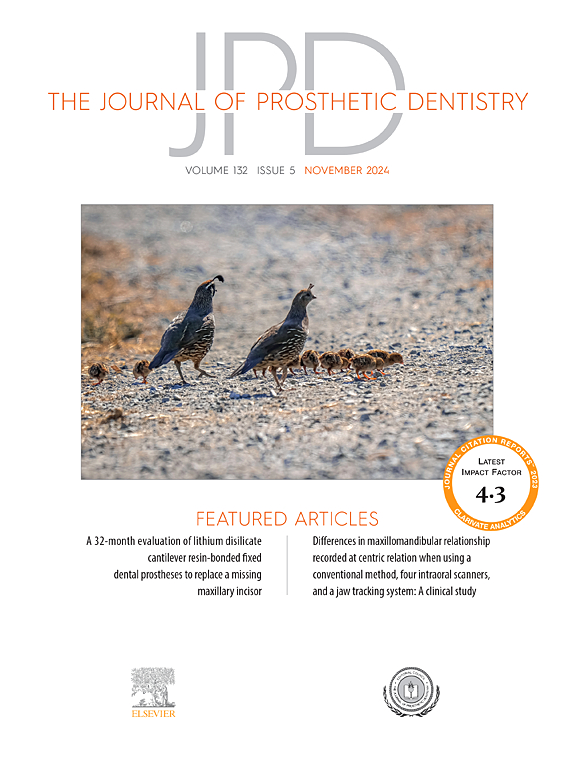Assessment of the internal connection of an angled screw channel system
IF 4.3
2区 医学
Q1 DENTISTRY, ORAL SURGERY & MEDICINE
引用次数: 0
Abstract
Statement of problem
The angled screw channel (ASC) design has been well accepted for implant prostheses. However, investigation into the behavior of the ASC connection is sparse.
Purpose
The purpose of this in vitro study was to assess the effect of cyclic loading on the internal connection of an ASC system compared with straight access systems by measuring reverse torque values (RTVs) and using microcomputed tomography (µCT) imaging.
Material and methods
Thirty dental implants (SLActive; Institut Straumann AG) were embedded in autopolymerizing acrylic resin and divided into 3 groups: Group V0, prefabricated abutment with a straight access channel; Group V25, prefabricated abutment with a 25-degree access channel; and Group C, cemented custom abutment with straight access. All specimens were initially secured with 10 Ncm using a digital torque gauge. A subset of specimens from each group (n=4) were randomly selected and assigned for µCT imaging examination and then reimaged after tightening to 35 Ncm. All specimens were subjected to cyclic loading for 5000 cycles with a loading force of 155 ±5 N at 1.2 Hz frequency in a 37 °C water bath using a fatigue machine. Repeat µCT imaging was done after cyclic loading for the representative specimens. The changes to the internal connection were measured on µCT images using a software program, and the RTV measurement of each specimen after cyclic loading treatment was recorded. The ANOVA test was used to analyze the statistical significance of the RTVs among groups (α=.05). The paired t test was used to conduct within-group comparisons of the measurement data.
Results
Mean ±standard deviation of RTVs varied from 29.05 ±2.99 Ncm to 29.75 ±2.61 Ncm, with no statistically significant differences among the 3 groups (P=.820). The distances from the base of the screw head to the apex of the screw-abutment-implant (SAI) system and internal air space volume within the groups V0 and V25 decreased significantly (P<.05) between the 10-Ncm and 35-Ncm torque applications. Off-axis loading resulted in rotational movement of the abutment that might have created a tensional force on the implant screw.
Conclusions
Results for the prefabricated abutment groups (V0, V25) indicated that the RTVs were not affected by the amount of angle correction. A counterclockwise rotational movement of the abutment and screw within the SAI system would be formed during off-axial loading.
斜螺槽系统内部连接的评定。
问题说明:斜螺钉通道(ASC)设计已被广泛接受用于种植体修复。然而,对ASC连接行为的调查很少。目的:本体外研究的目的是通过测量反向扭矩值(RTVs)和使用微计算机断层扫描(µCT)成像来评估循环载荷对ASC系统内部连接的影响,并与直接接入系统进行比较。材料和方法:种植体30颗(SLActive;在自聚合丙烯酸树脂中嵌入,分为3组:V0组,具有直接通道的预制基台;V25组,预制基台,25度通道;C组,直接进入的胶结定制基台。所有标本最初使用数字扭矩计用10 Ncm固定。每组随机抽取一部分标本(n=4)进行微CT成像检查,拧紧至35 Ncm后重新成像。所有试件在37°C水浴中,在1.2 Hz频率下,以155±5 N的加载力进行5000次循环加载。代表性标本循环加载后进行重复µCT成像。使用软件程序在微CT图像上测量内部连接的变化,并记录循环加载处理后每个试样的RTV测量值。采用方差分析(ANOVA)检验各组rtv差异有统计学意义(α= 0.05)。采用配对t检验对计量资料进行组内比较。结果:rtv的平均±标准差为29.05±2.99 Ncm ~ 29.75±2.61 Ncm, 3组间差异无统计学意义(P= 0.820)。V0组和V25组螺钉头基部到螺钉-基牙-种植体(SAI)系统顶端的距离和内部空间体积均明显减小(p)。结论:预制基牙组(V0、V25)的结果表明,rtv不受角度矫正量的影响。在离轴加载时,SAI系统内的基台和螺钉会形成逆时针旋转运动。
本文章由计算机程序翻译,如有差异,请以英文原文为准。
求助全文
约1分钟内获得全文
求助全文
来源期刊

Journal of Prosthetic Dentistry
医学-牙科与口腔外科
CiteScore
7.00
自引率
13.00%
发文量
599
审稿时长
69 days
期刊介绍:
The Journal of Prosthetic Dentistry is the leading professional journal devoted exclusively to prosthetic and restorative dentistry. The Journal is the official publication for 24 leading U.S. international prosthodontic organizations. The monthly publication features timely, original peer-reviewed articles on the newest techniques, dental materials, and research findings. The Journal serves prosthodontists and dentists in advanced practice, and features color photos that illustrate many step-by-step procedures. The Journal of Prosthetic Dentistry is included in Index Medicus and CINAHL.
 求助内容:
求助内容: 应助结果提醒方式:
应助结果提醒方式:


